When the Beatles Played their Hearts Out for a Quid a Night
Remembering Liverpool’s Cavern Club—a ‘cellar full of noise’ that launched a musical revolution
By Debbie Greenberg
Jan 24 2017

We were greedy for our fix of non-stop beat music. The club didn’t look like much from the outside. After dodging the lorries delivering fruit to the Fruit Exchange opposite and the lunchtime shoppers, we queued to get in through a small door in the wall of a towering brick warehouse at 10 Mathew Street.
Once inside we descended a steep flight of well-worn stone steps to a small landing, where a few more steps led to a man seated at a small wooden table taking the entrance fees. I paid an extra shilling to become a member of the Cavern Club entitling me to an admission discount at each visit — which in my case was most days. The heat and noise would send your senses reeling as you stepped through those cellar arches. It was enthralling and unbearably hot.
The Cavern’s identity began to change at the start of the new decade. Rock & roll slowly replaced jazz and the Cavern became the heart that gave Mersey its beat. We watched the Beatles debut at the Cavern at the lunchtime session on February 9th, 1961. We were blown away. The Beatles were different, their music was incredible, their appearance raunchy, their energy infectious. They just oozed excitement.
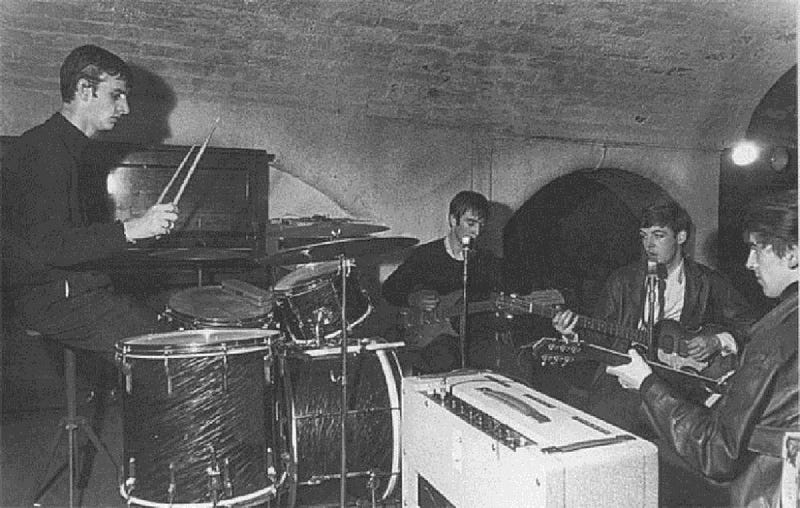
The Beatles rehearsing on the Cavern stage (photo courtesy Les Chadwick /Peter Kaye Photography)
Six weeks later on the 23rd of March, after a lunchtime session at the Cavern, they jumped on a train at Liverpool’s Lime Street station on their way to Hamburg for the second time, having previously played there in 1960. This time they sped off out of our lives for four months. We missed them but still went down to the Cavern to watch other groups, like Gerry and the Pacemakers, the Swinging Blue Genes, the Remo Four, the Big Three, Kingsize Taylor and the Dominoes, and many more. They were all fabulous groups but they weren’t the Beatles.
News soon spread around Liverpool that the Beatles were back from Hamburg and were to be guests of the Swinging Blue Genes at the Cavern on Friday July 14th, 1961 for their welcome home appearance.
Everybody wanted to see them. They were already by far the best group in Liverpool. Everything about them was exciting and intoxicating. They seemed to be infused with even more vigor and passion than before. The transformation was unbelievable, with their gyrating hips, humorous banter on stage and sexy outfits — clad in tight black leather with black Cuban heeled boots.
Their repertoire was now wide-ranging, making them stand out from other bands. Their sound was unique and addictive, their energy palpable. Liverpool had never seen or heard anything quite like them. Sue and I made sure we were at the Cavern for every one of their performances after that. They appeared every Wednesday night and every Monday, Wednesday and Friday lunchtime.
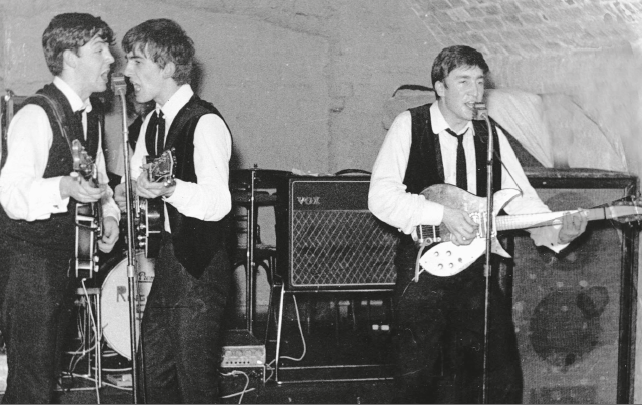
The Hamburg connection proved the ultimate testing ground for many Liverpool groups. On some nights, groups would be expected to play at the Top Ten Club or Kaiserkeller or later on the Star Club for up to seven hours with only a ten-minute break every hour.
Those sessions transformed Liverpool groups into totally professional outfits—none more so than the Beatles. It turned them from talented amateurs into the band of bands, as Klaus Voormann described them. The Cavern was soon packed every time they played.
Bob Wooler booked them and they received £5 for their debut (£1 each). At that time Stuart Sutcliffe was playing bass guitar, although not very well, and he would often play with his back to the audience so no one could see how he was playing.
They had played a few numbers with Tony Sheridan in Hamburg, including “Ain’t She Sweet,” but the one that sticks in my memory is “My Bonnie.” When the Beatles played these songs at the Cavern they were absolutely brilliant. I think Tony had a big influence on how the Beatles dressed and moved. John Lennon copied Tony’s posture, holding the guitar high up on his chest.
Tony was very talented but by all accounts a force to be reckoned with. His mood could change in an instant. It must have been difficult to work with somebody so unpredictable. They had first met when both were playing for a season at the Top Ten Club in Hamburg. German bandleader Bert Kampfert had spotted them and arranged for them to cut a disc of “My Bonnie” together, which was released in Germany.
News of this record filtered back to Liverpool and one fateful day, Saturday October 28th 1961, a Liverpool teenager called Raymond Jones went into NEMS record store asking about the disc. Situated on Whitechapel, NEMS was just a stone’s throw from Mathew Street and the Cavern.
The young store manager was Brian Epstein, who prided himself on being able to source any record that had been officially released. After hearing the track with its throbbing beat he was intrigued. He asked his assistant, Alistair Taylor, to arrange a visit to the nearby Cavern to see the Beatles at one of the lunchtime sessions. He got there on November 9th 1961 with Alistair and saw the Beatles play for the first time.
He was entranced by their performance — and by the Cavern, the place he later called a “cellar full of noise.” However, Brian Epstein was not the first candidate for the position of Beatles manager. A Liverpool-based promoter called Sam Leach, who regularly organized dances and live shows in local venues, frequently hired the Beatles. As he was giving them regular work and they were all very good friends, he suggested he should become their manager.

Beatles’ first manager Sam Leach with Dick Matthews, John Lennon and George Harrison at the Palais Ballroom, Aldershot (Photo: Paul McCartney)
The group agreed and on the strength of a handshake with John Lennon, the group’s leader, he thought he’d secured the position as their first manager.
On December 9th 1961 Sam booked the Palais Ballroom in Aldershot, about forty miles outside London. He paid for a full-page ad in The Aldershot News and expected a good turnout for the gig. However, he had paid by check and the newspaper would not insert the ad until the cheque had cleared.
The check didn’t clear in time and on that night only eighteen people turned up to see the Beatles.
After the hiccup at Aldershot everything was going very well for a few weeks until Brian Epstein stepped into the frame. The Beatles, ever eager to climb the ladder of success, were tempted by Brian’s obvious wealth and promises of fame and fortune. With a heavy heart John Lennon had to break the news to Sam that they had signed with “Eppy.”
Eppy was attracted to the group not just for their music; he was besotted by their personalities and he was especially attracted to John. As a closet homosexual he was all too aware that his sexual preference was still a criminal offence. But he had the skills, contacts and commitment to help them succeed.
After becoming their manager he vowed to get them a recording contract through his connections in the music scene. After many initial rejections he finally succeeded.
Overnight the Beatles had a following of devoted fans and I was one of them. The amazing thing about the Cavern was that the Beatles and all the groups were so accessible. We were literally inches away as they played.
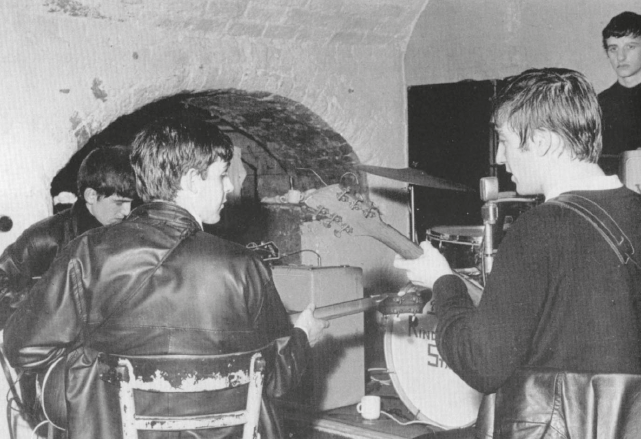
The Beatles rehearsing on the Cavern stage (photo courtesy Les Chadwick / Peter Kaye Photography)
The girls went crazy when Pete Best was sacked and replaced by Ringo. Pete was sultry, fiercely good-looking and oozed sex appeal. They would heckle the Beatles when they were on stage, shouting, “Pete forever, Ringo never.” We were all outraged and couldn’t understand why Ringo was the new drummer. The sound didn’t seem any different to us.
Rumours about Pete’s dismissal circulated around Liverpool. Some said he was too good-looking and Paul was jealous because he was getting the most attention from the girls. Others said Brian Epstein had decided his drumming wasn’t good enough. I don’t suppose any of us will ever get to the bottom of it; even Pete Best didn’t know why he was dropped.
The Beatles inspired many groups to embrace rock & roll — and they all wanted to play the Cavern. The resident DJ, Bob Wooler, would always introduce the show with, “Hi there, all you cave-dwellers. We’ve got the hi-fi high and the lights down low.” At the end of the night he always played “I’ll Be There” by Bobby Darin and we all knew it was time to leave. It was never the signal to get romantic as it was in other clubs. It was just time to go and catch the last bus home.
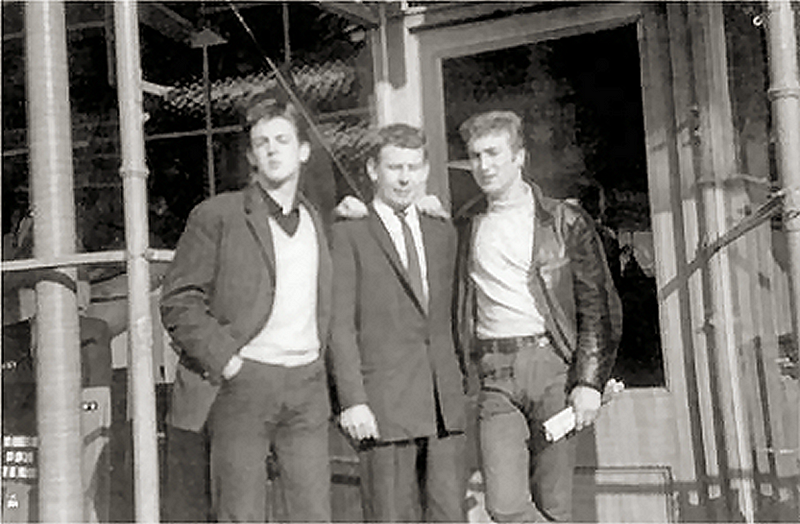
Paul McCartney (left), John Lennon (right) with Bob Wooler, Cavern Club’s DJ, in the summer of 1961 (source)
Bob later said, “The Cavern was the greatest finishing school pop music had ever known.” How right he was.
Garston-born Bob compered around Liverpool for four years before giving up his day job as a British Rail clerk to go full-time as a DJ in 1960. His first gig was at Litherland Town Hall on Dec 27th 1960, the first major show the Beatles played on their return from their first Hamburg trip. They delivered an incendiary performance, the likes of which Liverpool had never seen before. He would go on to compere lunchtime and evening sessions at the Cavern from 1961 until it was closed in early 1966.
“It was dirty. It was incredibly noisy. It stank to high heaven,” Bob remembered in a 1973 interview with Don Smith of the Liverpool Daily Post. “But it put Liverpool on the map so far as teenagers throughout the world were concerned. It was not just a place but an experience, a revolution. I should know, I saw it through the halcyon years, right through to the bankrupt years. Fed up with my job as a railway clerk, I took a chance and jumped down into the Cave, as I still call it, as a part-time/lunchtime disc jockey and compere. I found myself in a different world. I stayed in it for seven years. The happiest years of my life.
“A lot of rubbish has been written about the place, mostly by people who had either never been in it, or spent a few minutes there before dashing out, deafened. People said it made a fortune, that it led youngsters astray, that it was a vice midden. It was far from that. And it never, as has been suggested, exploited the penniless pop groups that queued to play there.
“It’s true the Beatles played their hearts out for a quid each a night, but there was nowhere else for them to play anyway, and they and the groups that followed were glad of the chance. I compered exactly 292 Beatles shows down in that sweaty hole. They loved every minute of it, so did the kids, and remember it was the kids who made the Cavern, not the Beatles, or the long line of groups that followed on.”
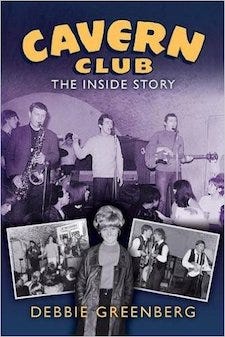
Excerpted from Cavern Club: The Inside Story by Debbie Greenberg, published by Jorvik Press. Available now from Amazon, Barnes & Noble and other fine retailers.

No hay comentarios:
Publicar un comentario